

Not every innovation works
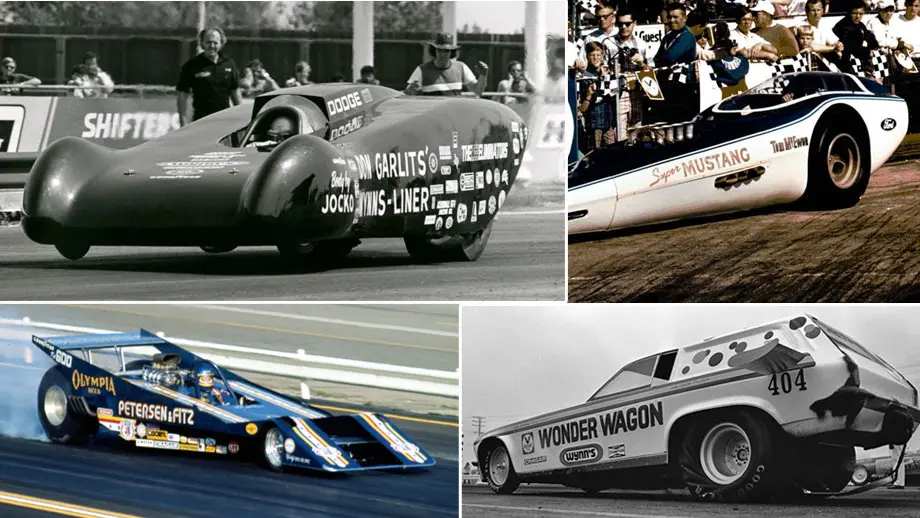
Input from last week’s column about the Cars That Changed Drag Racing was, as expected, voluminous and wide-ranging. There were some really good recommendations for the list (still open; pitch in!) and a few pretty out-there suggestions, but as I work my way through the candidates that succeeded in making an impact on the sport’s future, I kept drifting back to thinking about cars and trends that didn’t quite work out.
Innovation has always been a hallmark of all motorsports, and drag racing in the 1950s-70s was certainly on the wild west of that frontier. New ideas — sometimes brilliant, sometimes harebrained — surfaced every weekend at tracks across the country. When someone came up with an idea that worked, it often was copied, and others built upon it. I’m partial to the quote by 18th-century poet, painter, and printmaker William Blake who said, “What is now proved was once only imagined.”

Of course, the flip side of that coin is every great idea that didn’t pan out, which is, naturally, to be expected, as social research Professor Brené Brown succinctly observed, “There is no innovation and creativity without failure. Period.”
Or to paraphrase drag racing-loving comedian Christopher Titus (who was himself paraphrasing Thomas Edison), “We didn’t fail as much as we succeeded in finding out what doesn’t work.”
But enough philosophizing and quote grabbing. Here’s a quick list of cars and ideas, some of which utterly failed, some that just didn’t catch on, and some that maybe were just ahead of their time and current technology.
Presented below in no particular order or degree of “finding out what doesn’t work”:
Maybe because he’s been so spectacularly successful with so many of his cars, any time that Don Garlits tries something that doesn’t work out, it sticks out in your memory, which is the case with Swamp Rats 17 and 27.
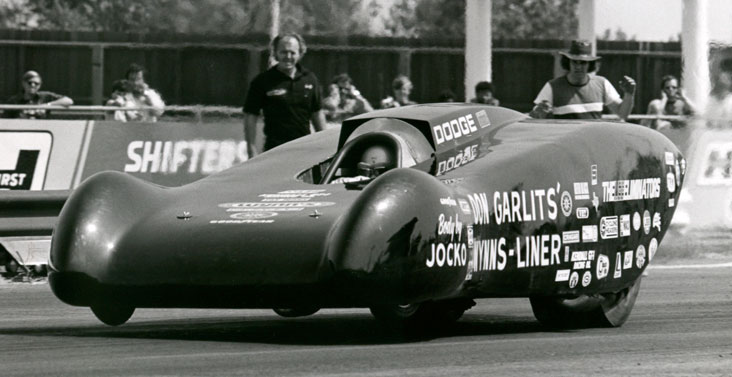
Swamp Rat 17, also known as the Wynn's Liner, was Garlits’ first in-depth attempt at aero trickery. Designed by Jocko Johnson, the swoopy-looking black shell was plopped atop a 180-inch wheelbase rear-engine dragster chassis. It made several runs on the West Coast in 1972, but neither Garlits nor Butch Maas nor Don Cook could get it down the track as the car tended to get light at the top end, making it all but undrivable and safe. It was sold to rocket-car racers Russell Mendez and Ramon Alvarez, and “Big Daddy” went back to kicking everyone’s butts with a conventional car.
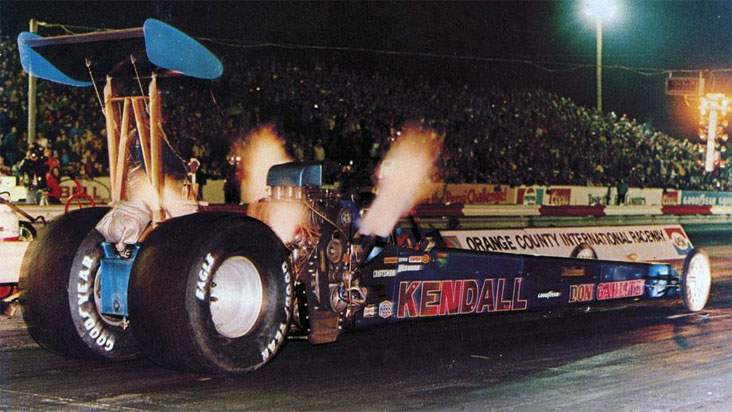
Ten years later, Garlits put a lot of thought, engineering, and effort into Swamp Rat 27, better known as the sidewinder. I wrote a whole column about that car that you can find here. It truly was a promising and forward-thinking idea, but they didn’t have the right material for the gearsets that drove the power to the rear tires, and the parasitic losses through the gearsets robbed what did get there.

Of course, Garlits was not the first to try the sidewinder approach. Jack Chrisman ran a sidewinder dragster back in the 1960s then resurrected the idea with a chain-driven, Woody Gilmore-built rear-engined Mustang Funny Car. He barely ran it, bailed on the ideas, and it later became John Force's first Funny Car (the Night Stalker) and was a miserable failure, as you can read here.
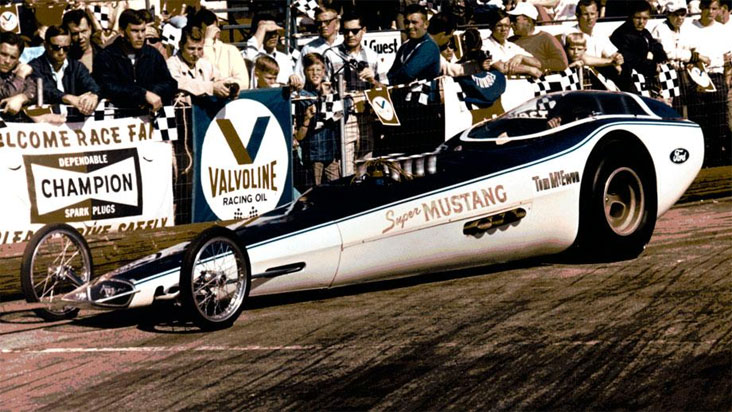
One of auto manufacturer Ford’s longtime slogans was “Ford has a better idea,” but the Super Mustang was not one of them. This half dragster/half Funny Car was initially commissioned as a promotional tool but actually competed at the 1967 Winternationals with the famed “Mongoose,” Tom McEwen, at the controls. With a 150-inch chassis built by the Funny Car pioneering Logghe brothers that sported a Posi-Traction rear end suspended by a pair of coil-over shocks, traction bars, and an anti-sway bar, it certainly was not your average dragster. The chassis was covered in a wind-tunnel-tested body complete with a bubble cockpit canopy. Power came from an injected 427 SOHC Ford engine, but it couldn’t get out of its own way and was quickly shelved. “It was, to put it bluntly, a dog,” McEwen told me.
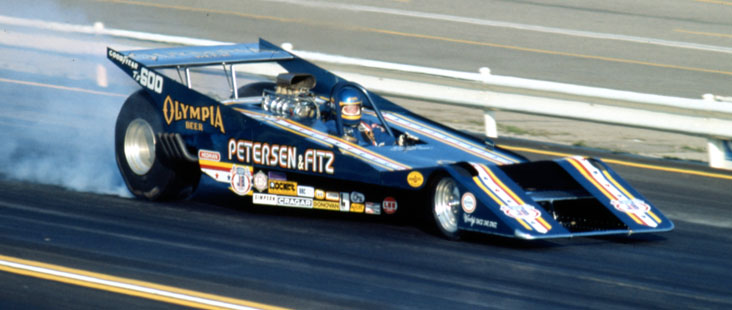
Garlits was certainly not the first or last to discover that aerodynamics is a tricky business whose success hinges upon forces of nature and gravity as much as it does theory and materials. Famed chassis builder Woody Gilmore teamed with Northwest nitro legend Herm Petersen and Sam Fitz to create what could have been another revolutionary Top Fuel design in 1974, a Can Am-inspired rear-engined dragster. Its anodized bodywork covered the engine and both front and rear tires, with the rear wing integrated into the bodywork. The car failed to qualify in its debut at the Winternationals and probably wouldn’t have been in the Gatornationals field if it were not for NHRA’s then rule of seeding the defending event champ into the field, and it lost in round one there with a run that would not have qualified. Unlike Garlits’ ‘liner, Petersen’s car handled perfectly but, by his own admission, it was 200 pounds too heavy. The Can-Am car made just 19 runs in its short life.

Weight has always ultimately been the issue when it comes to hanging aerodynamic aids on dragsters, but also the cumbersome nature of the appendages that got in the way or added extra time to between-rounds maintenance. Both of those issues certainly helped bring an end to the wedge dragster period of the early 1970s (as recounted in many, many articles here). When legends like Connie Kalitta, Don Prudhomme, and Chris Karamesines can’t get them to work, you know there’s an issue. Although Prudhomme’s Hot Wheels wedge did enjoy some fleeting successes, they too were soon reconciled to the scrap heap.
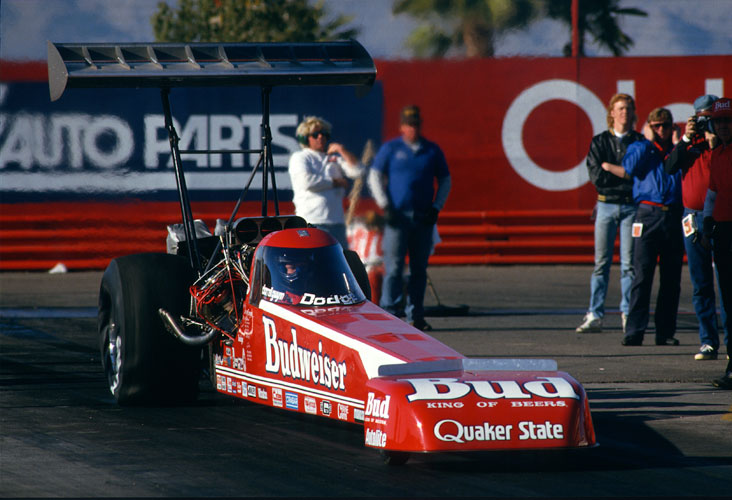
I guess it’s understandable that 1970s streamlined dragsters were challenged by weight with the era’s available building materials, but even when carbon fiber and titanium became more readily accessible, modern-era streamliners came and went quickly in the mid-1980s. While Garlits’ Swamp Rat XXX was an unqualified success in 1986, its only real aerodynamic accouterments were a spoon nose and a cockpit canopy, while Gary Ormsby’s same-year Castrol GTX streamliner, with its full, IndyCar-styled body, struggled with weight and complexity. Both Darrell Gwynn and Joe Amato also went the nose/canopy way but neither lasted long in that configuration. You can read more about these modern streamliners in this column I wrote a few years ago.

More a trend than a car design, front-wheel pants on Top Fuelers sure looked cool (I defy you to look at the beautiful Keeling & Clayton dragster and imagine that it would have looked better without them) but were controversial almost from the start when several pants-equipped dragsters (most memorably those of Dick LaHaie and Tommy Ivo) crashed at speed. The idea of covering the front tires seemed natural (and was Garlits’ big goal in 1986), but their design seemed to make them susceptible to crosswinds that could almost take the butterfly right out of a driver’s hand. With the help of longtime Insider reader Mark Gredzinski, I was able to compile a list of more than 25 Top Fuel dragsters that donned pants. We found examples as early as 1964, when Craig Breedlove had them on his front-engined Spirit of America, but most commonly in the early 1970s until NHRA outlawed them for the 1977 season.
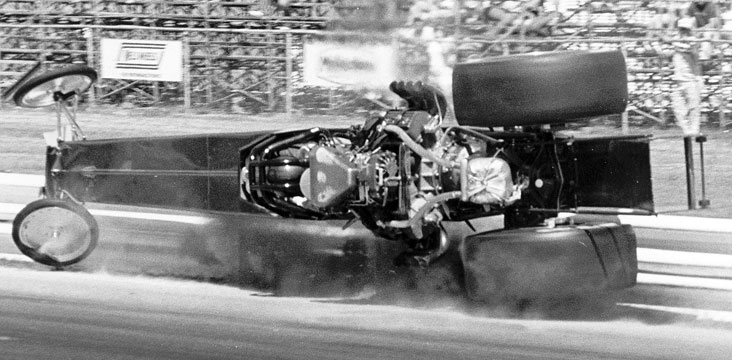
Another unobtainable aero goal for some Top Fuel racers was the elimination of the rear wing. We all know that the wings are so important for providing downforce to keep the cars stable at speed, but they’re also a huge aerodynamic drag. Formula 1 racers long ago figured out that there was “free” downforce to be had with the addition of under-body belly pans and tunnels, and drag racers certainly took their swings at the magical science of “ground effects,” too. Respectfully discounting the issue that probably contributed to Pete Robinson’s fatal accident years earlier, no ground-effects car failed more visibly than the Phil Hobbs-driven Barber & Engler Top Fueler at the 1984 NHRA U.S. Nationals.
There, on drag racing’s grandest stage, the wingless machine lost traction right off the line, hooked a hard right, went onto its left side, and smashed the guardrail with its underside before hurting the guardrail and, with the throttle hung wide open, rubbed along the inside of the guardrail for hundreds of feet. Despite that failure, others continued to dabble with wing removal/reduction in the later 1980s and early 1990s, including multitime champ Joe Amato, Gene Snow, and Jim Head, but none with any success.

Once Garlits proved that a rear-engine design could work in Top Fuel, Funny Car racers thought they’d give it a try, too. Dozens of rear-engined Funny Cars were built in all shapes and sizes, but only one, Jim Dunn’s Barracuda, succeeded on any level. Most ended up as a pile of rubble, but “Big Jim’s” ended up in the winner’s circle at the 1972 NHRA Supernationals and remains (and probably will remain) the only rear-engined Funny Car to win an NHRA national event. The overwhelming problem for these machines was the flopper’s inherent short wheelbase that put the driver’s feet on the front axle and made steering a real chore and was always, as the kids today say, "pretty sketchy.” Or as Dunn pointedly noted, “It did things for no reason with no warning."

But even conventional Funny Cars had their challenges. Corvette bodies initially were considered jinxed until McEwen found the correct rear-wing configuration and they became popular. There was no saving the reputation of the Chevy Vega panel wagon, as I detailed in a couple of stories chronicling the wild nature of Don Schumacher’s Wonder Wagon Funny Cars of the early 1970s. As intriguing and different as they looked, no amount of canards or body alterations could keep them from trying to take flight at the top end.

On the same theme of “it worked in dragsters but not in Funny Cars” was the idea to wedge more than one engine into a bodied car. After all, twin-engine gas dragsters worked just fine in the 1960s through the early 1970s, but trying to jam two engines under one roof proved to be mostly futile and often disastrous. Some Funny Car racers tried the combination, including Don Hampton, whose American Bandstand Corvette had side-by-side small-block Chevy power; Dean Dillingham, whose A&W Root Beer Special Nova sported twin Chevy small-blocks inline; and Junior Brogdon’s Phony Pony Mustang, which had injected small-block Fords inline. They’re neat, but just don’t make serious race cars, which is why Tommy Ivo’s Showboat was a much better exhibition car than a race car. The hall of shame standard bearer remains John Smyser’s Terrifying Toronado that had twin 425-cid Oldsmobile engines, one in the conventional place and one in the back seat, and four-wheel drive. The 4,500-pound terror was just a handful that it twice exited the racetrack either through or over guardrails and was retired. If your nerves can handle it, you can read more about the Terrifying Toronado here.
I bring all of these examples to mind not to mock them but to salute them, for without them all saying, “Hey, what do you think would happen if we …” we would have a lot more unanswered questions. It’s truly a case of that other famous saying, “Pioneers are the ones who get the arrows in their butts.”
Sometimes, we didn’t know what we needed. We just needed something different. After all, where would we be today if Henry Ford had listened to the masses instead of deciding to build his “horseless carriage?”
“If I had asked people what they wanted, they would have said faster horses,” Ford famously said. Ford didn’t/couldn't do that, so he took the next step. It could have been a disaster but ended up changing all of our lives. Some of the above could have gone the same way and changed how the sport progressed, but their success in showing us what couldn’t work allowed us to channel our efforts into things that could work. And for that, I salute them.
Phil Burgess can be reached at pburgess@nhra.com
Hundreds of more articles like this can be found in the DRAGSTER INSIDER COLUMN ARCHIVE



















































